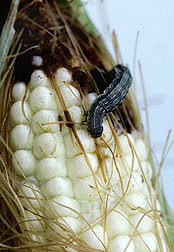This page has been archived and is being provided for reference purposes only. The page is no longer being updated, and therefore, links on the page may be invalid.
| Read the magazine story to find out more. |
|
|
Flower Power Puts a Hurt on Caterpillars
By Jan SuszkiwAugust 16, 2011
U.S. Department of Agriculture (USDA) scientists in Peoria, Ill., are investigating the pest-fighting potential of anthocyanins, healthful chemical compounds in the form of plant pigments that give blueberries, plums, grapes and flowers such as petunias their blue and purple color.
In experiments conducted at the National Center for Agricultural Utilization Research, operated in Peoria, Ill., by USDA's Agricultural Research Service (ARS), corn earworm caterpillars forced to feed on blue areas of petunia petals gained less weight than larvae that fed on white areas. ARS is USDA's principal intramural scientific research agency.
Additional experiments showed that anthocyanins isolated from the petunia petals also slowed the caterpillars' growth rate. Cabbage looper caterpillars were also evaluated. Those that ate the blue petal areas of a petunia cultivar used in the tests died at higher rates than larvae that ate the white areas.
Although it's unclear what petal compound or compounds were involved in the loopers' deaths, their toxicity was apparently increased by the anthocyanins' presence, according to Eric T. Johnson, a molecular biologist with the center's Crop Bioprotection Research Unit.
He and his colleagues also are interested in maize proteins that are produced during the crop's seedling stage. The seedlings are quite resistant to insects, and the researchers suspect this may be partly due to a combination of resistance biochemicals and proteins.
If the proteins' resistance role can be confirmed, then it may be possible to express the genes responsible for those proteins at a later stage in the plant's life cycle. However, this would be contingent upon expressing them at sufficient levels, adds Johnson.
Ultimately, studies of plant-produced substances like anthocyanins could give rise to new crop varieties that boast dual-use phytochemicals—fighting pests on the one hand and benefiting human health on the other.
Read more about the research in the August 2011 issue of Agricultural Research magazine.

